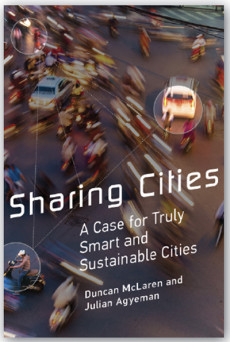
Sharing Cities: A Case for Truly Smart and Sustainable Cities
Duncan McLaren & Julian Agyeman
426 pages, MIT Press, 2015
This fall, I traveled to Seoul, South Korea, to give a speech on the global sharing economy. While I was there, I met with Park Won-soon, the mayor of Seoul, and saw him deliver an impassioned speech about the power of the sharing economy to build community, to improve local government, and to create thriving, sustainable cities. Then I traveled to California, where I was greeted by headlines that proclaimed the sharing economy to be a root cause of precarious work, rising income inequality, and gentrification. I thought to myself: Are people like Park and the people who write those headlines even talking about the same thing?
This conundrum lies at the heart of Sharing Cities, by Duncan McLaren and Julian Agyeman. McLaren, an environmentalist, and Agyeman, a professor of urban and environmental policy and planning at Tufts University, tease out the many varieties of “sharing” that exist in the sharing economy. They also investigate what each variety means for the future of sustainable growth and social cohesion. In doing so, they reveal important issues that may affect the potential of the sharing economy to improve people’s lives.
But first let’s set the stage: People are moving into cities worldwide at an unprecedented rate. The global urban population is growing by the equivalent of one Copenhagen-sized city every week. Technology, meanwhile, is enabling people to reinvent almost every aspect of their lives—from how they connect to how they consume to how they work, travel, and learn. These two trends have given rise to social models that involve the sharing of assets for financial or nonfinancial purposes. The spread of these models is especially prevalent in cities because cities have dense concentrations not only of people but also of shareable assets.
“At the heart of our case for the sharing paradigm,” McLaren and Agyeman write, “is an understanding of justice as universal access to the capacities and abilities we need to flourish.” A true sharing economy, they argue, is one that values “just sustainabilities”—qualities such as social equity and inclusiveness—rather than efficiency and profits. But that version of the sharing economy is at risk of being co-opted by commercial interests. Even leisure, the authors contend, has become “a battleground of commodification.” The danger is that in our pursuit of more flexible lifestyles, we will set in motion “a race to the bottom:” a process in which consumers replace citizens, the rich get richer, and minorities are marginalized.
McLaren and Agyeman do an exemplary job of raising these and other thorny issues. They challenge us to ask: What does a truly “smart and sustainable” city look like, and how does this model overlap with the sharing economy? Do current approaches to the sharing economy factor in the values of economic and social justice—and if so, to what degree? Are the entrepreneurs who develop these approaches simply “sharewashing” private interests?
Sharing Cities covers a broad range of topics, from Silicon Valley start-ups and neighborhood cooperatives to land rights and tax policy. Drawing on philosophers from Aristotle to Amartya Sen, the authors also explore how ideas about sharing have evolved over many centuries. Yet the book’s greatest strength is also its greatest limitation: in attempting to tackle such a broad range of subjects, McLaren and Agyeman dilute and at times muddle their message. The book is an excellent resource for people who already have an interest in the sharing economy, but its complexity will lessen its appeal for people who are new to the topic.
There is no one path to becoming a sharing city; many approaches can work. The truly stellar examples—such as Seoul and Amsterdam—are those in which city government applies the sharing economy to its own operations, enables a range of business models, and gives priority to the values of community. In cities where people focus largely on promoting private-sector models (San Francisco is an example), the risk of commodification, co-option, and a loss of community is much greater.
But the relationship between commercial and noncommercial approaches is not zero-sum. Much depends on how a platform is commercialized. To build a sharing economy that is sustainable, just, and efficient, we need to pursue both nonprofit and for-profit models. Perhaps more important, we need to develop new models that allow for the co-ownership of assets by people who use those assets.
I am reminded of the first line of the Charles Dickens novel A Tale of Two Cities: “It was the best of times, it was the worst of times, it was the age of wisdom, it was the age of foolishness. …” All around us, I see encouraging signs of the potential for the sharing economy to benefit cities. But I also see reasons for concern about sharing-economy models that don’t take into account broader social issues. Sharing Cities is a wake-up call to policy makers, businesspeople, and community leaders: There has never been a better—or more urgent—time to build a shared urban future.

